The SanDisk X400 1TB SSD Review
by Billy Tallis on May 6, 2016 9:00 AM ESTATTO
ATTO's Disk Benchmark is a quick and easy freeware tool to measure drive performance across various transfer sizes.
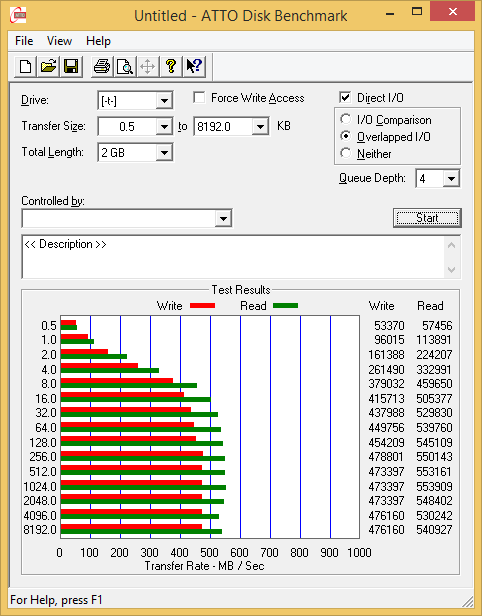 |
|||||||||
Aside from the write speeds that lag behind read speeds by a larger than normal margin, the ATTO results are reasonable and do not show signs of any major problems.
AS-SSD
AS-SSD is another quick and free benchmark tool. It uses incompressible data for all of its tests, making it an easy way to keep an eye on which drives are relying on transparent data compression. The short duration of the test makes it a decent indicator of peak drive performance.
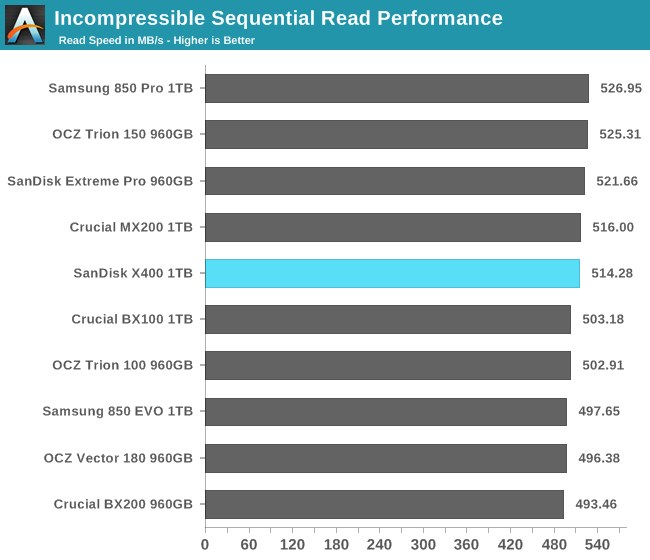
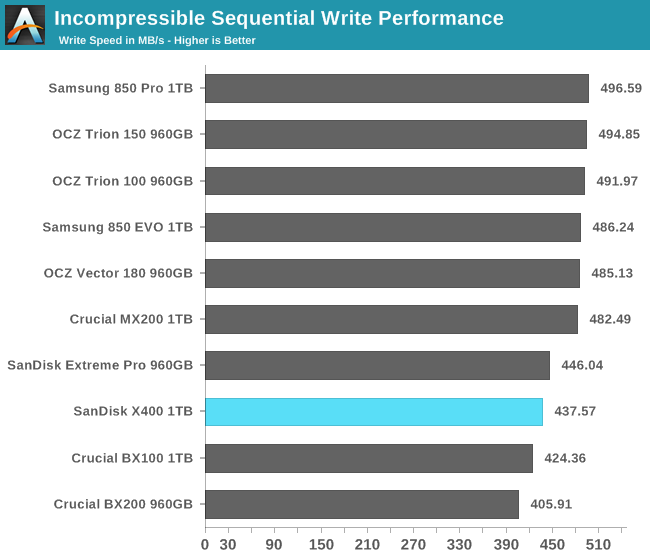
None of these drives show any meaningful difference in AS-SSD sequential read speed, but the write speed limitations of the X400 do show up clearly on this test.
Idle Power Consumption
Since the ATSB tests based on real-world usage cut idle times short to 25ms, their power consumption scores paint an inaccurate picture of the relative suitability of drives for mobile use. During real-world client use, a solid state drive will spend far more time idle than actively processing commands. Our testbed doesn't support the deepest DevSlp power saving mode that SATA drives can implement, but we can measure the power usage in the intermediate slumber state where both the host and device ends of the SATA link enter a low-power state and the drive is free to engage its internal power savings measures.
We also report the drive's idle power consumption while the SATA link is active and not in any power saving state. Drives are required to be able to wake from the slumber state in under 10 milliseconds, but that still leaves plenty of room for them to add latency to a burst of I/O. Because of this, many desktops default to either not using SATA Aggressive Link Power Management (ALPM) at all or to only enable it partially without making use of the device-initiated power management (DIPM) capability. Additionally, SATA Hot-Swap is incompatible with the use of DIPM, so our SSD testbed usually has DIPM turned off during performance testing.
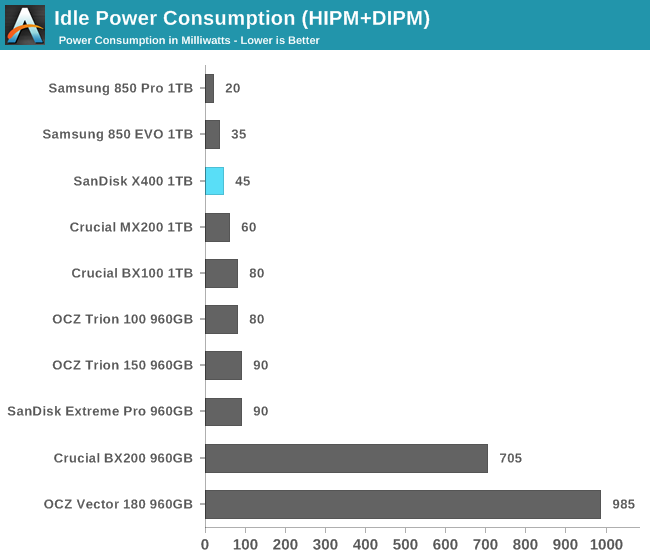
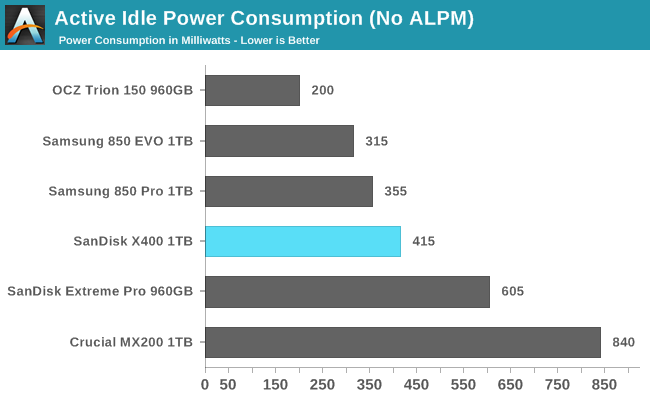
Slumber power drawn by the X400 is not quite the lowest but is still pretty good, but active idle power is twice as high as the OCZ Trion 150 based on the Toshiba TC58/Phison S10 controller platform.










41 Comments
View All Comments
Margalus - Friday, May 6, 2016 - link
It uses less power than some, and is priced lower. But it seems performance is severely lacking..jabber - Friday, May 6, 2016 - link
This just shows what a fantastic budget SSD the BX100 was. Crucial were stupid to dump it.Mixal11 - Sunday, May 8, 2016 - link
Exactly, for me it's v300 for low end desktop, BX100 for laptops (hard to get over time) and Sandisk Extreme Pro or 850 Pro for high end. I avoid TLC, because of experience with Dell Samsung 841oem. Who knows if I can read data from it after year or two. TLC drives are great to reduce ssd prices.jabber - Sunday, May 8, 2016 - link
Yeah everyone moaned about the V300's back in the day but they are perfect SSDs for putting in SATA II kit as they push 285+MBps all day long...plus they are the cheapest you can buy usually. Also I have bought dozens of them and not one has yet failed. They are a solid tough little SSD. I shall be sorry when they go.jhh - Friday, May 6, 2016 - link
I wonder if they have included any of the increased endurance technology from their Smart Storage (formerly part of Smart Modular) acquisition. The idea behind the technology was that most cells didn't need full current to program, and when programmed with less than full current, that the cell would allow more write/erase cycles.Michael Bay - Friday, May 6, 2016 - link
Goddamn it, one more terabyte.Just one.
Samus - Friday, May 6, 2016 - link
I think if I were shopping for a TLC drive I'd stick with Sandisk too. I haven't had any issues with their Ultra II's, although many people have. I have, however, had two ADATA SP550's fail (a 120GB and 240GB) one during a power failure in a laptop (BSOD) which a secure erase recovered usability of the drive, and another within an hour of installation - cloning about 100GB of data to it killed it an no longer detects by BIOS.I have 5 or so other SP550's in the field running fine though, but none of them have suffered the "abuse" of the above cases.
I have dozens of Mushkin drives out there, even ECO2's, all running incredibly well. I have a few ECO3 TLC drives in house about to go out, but I've been avoiding them because the ECO2 is still available.
On a side note, I still have 840EVO's coming in at least bi-weekly with basically unusable performance. Samsung is hell to deal with for RMA (a stark contrast to, say, OCZ that actually sends you an advanced replacement!) and nothing I can do revives performance in these drives. Secure erase, fill and trim, etc, nothing works. Even after a fresh OS install they read at half the speed they write. It's crazy, slower than a 2.5" hard disk.
ladder_to_heaven - Friday, May 6, 2016 - link
Win 8.1 - STILL? -For the love of god WHY?
Billy Tallis - Friday, May 6, 2016 - link
Switching to Windows 10 would require re-testing a lot of drives, monopolizing the testbed for a month. It'll probably happen at some point this year, but I'll need to put together a second system for it (hopefully a Skylake system with working PCIe power management).jabber - Saturday, May 7, 2016 - link
Yeah no rush, after all 85% of 10's code is...8.1.